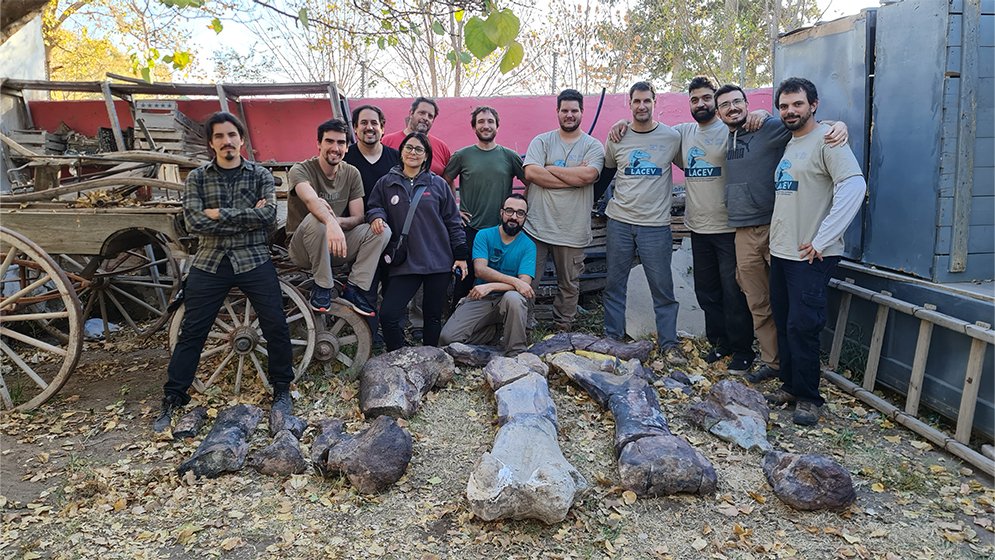A team of paleontologists from the National Council for Scientific and Technical Research (CONICET) found the skeletal remains of a new giant long-necked herbivore dinosaur that lived in what is now the Patagonian province of Río Negro (Argentina) around 90 million years ago years ago, during the Late Cretaceous (last of the dinosaur era periods).
The study of the new species, named Chucarosaurus diripienda, has been Published in an article in the journal Cretaceous Research.
The remains found, made up of different elements from the extremities of two different individuals, were discovered about 25 kilometers south of Villa el Chocón at the end of 2019, as part of a campaign by the paleontological team of the Laboratory of Comparative Anatomy and Evolution .dos Vertebrates from the Argentine Museum of Natural Sciences “Bernardino Rivadavia” (MACNBR, CONICET), by researcher Fernando Novas.
A large number of dinosaurs have already been found in this locality, including large carnivores such as Taurovenator violantei, Aoniraptor libertatem and Tralkasaurus cuyi, and other small ones such as Overoraptor chimentoi.
Due to the size of the femur (about 2 m), it is estimated that this dinosaur weighed between 40 and 50 tons and was about 30 m long.
In turn, remains of other reptiles that lived in the shadow of dinosaurs were discovered, such as crocodiles, turtles and tuataras. However, no herbivorous dinosaurs have been found so far.
Chucarosaurus is a titanosaur belonging to the group of colosaurian sauropods (Colossauria). It has a long neck and, due to the size of its femur, which is about two meters long, it is estimated that it weighed between 40 and 50 tons and was about 30 meters long. This makes it the largest species found so far in the province of Río Negro”, says Matías Motta, CONICET researcher and co-author of the work.
To carry out the phylogenetic analysis, which made it possible to determine the phylogenetic belonging of Chucarosaurus to the group of colosaurs, the contribution of Bernardo González Riga, CONICET researcher at the Interdisciplinary Institute of Basic Sciences, was essential.
According to Motta, its 30 meters in length put Chucarosaurus on the same level as other gigantic Cretaceous herbivore dinosaurs discovered in the south of the South American continent, such as Argentinosaurus, Patagotitan, Notocolossus, and which are also among the largest in the world. .
The region of Patagonia is known for the recurrent discovery of remains of large herbivorous dinosaurs.
“However, the known bones of Chucarosaurus are notably more graceful, which suggests that it must have been much more slender than other giants,” says Federico Agnolín, first author of the work and a researcher at CONICET at MACNBR and the Fundação de História. Felix of Azara.
“Although dinosaurs larger than Chucarosaurus have been discovered, the new species from the Rio Negro joins the group of large herbivorous dinosaurs that dominated terrestrial ecosystems at the end of the Cretaceous”, adds Motta.
The region of Patagonia is known for the recurrent discovery of remains of large herbivorous dinosaurs. These supergiants seem to have been very abundant and successful in South America and have been recorded in the provinces of Mendoza, Neuquén, Chubut, Santa Cruz and Río Negro.

Part of the team that worked on the extraction, preparation and study of the fossil remains. /CONICET
A very different habitat
Chucarosaurus was found along with a large amount of plant remains, in rocks that indicate the existence of mighty rivers. In the vicinity of Chucarosaurus, researchers found the remains of a huge predatory dinosaur called Taurovenator. All these discoveries allow paleontologists to better understand how the ecosystem north of the Rio Negro was like around 90 million years ago.
The remains of Chucarosaurus will be exhibited at the Carlos Ameghino Provincial Museum in Cipolletti (Argentina)
The authors emphasize that one must take into account that, at the end of the Cretaceous period, Patagonia was very different from what it is today. Far from the arid plateaus with thorny forests, the region at that time was covered by araucaria forests and a great diversity of other plants, and with a landscape dotted with lakes, ponds and rivers, which allowed the development of different types of animals.
“The study of Chucarosaurus expands the anatomical knowledge of the appendicular bones of titanosaurs, such as the humerus, femur, ischium and tibia, which have diagnostic characters at the species level, which demonstrate greater morphological diversity than was previously known. These differences must be linked to various ecological adaptations in the continental fluvial environments where they inhabited”, concludes González Riga.
The remains of Chucarosaurus will be exhibited at the Carlos Ameghino Provincial Museum, located in the town of Cipolletti, in the province of Río Negro.
Reference:
Agnolin, FL, et al. “A new giant titanosaur (Dinosauria, Sauropoda) from the Late Cretaceous of Northwestern Patagonia, Argentina”. Cretaceous Survey (2023)